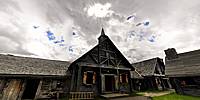
Wood Structures in the ‘New World’ 1639-1649
Sainte-Marie among the Hurons, Midland, Ontario Canada
August 5, 2017 at 3:50 PM EST 15:50
© 2017 Robert Julian Agnel, All Rights Reserved.
Wood Buildings in the ‘New World’ 1639-1649
The mission "Sainte-Marie among the Hurons" was founded in 1639 by French Jesuits. The mission was in the land of the Wendat nation located north west of Lake Simcoe and south of Georgian Bay in what is now the Province of Ontario, Canada. The mission was built on the Wye River near the Wendat settlement of Quieunonascaranas, led by chief Auoindaon.
The Wendat Hurons to the French were an organized very spiritual agricultural-based people. They lived in a region called Wendake known today as Huronia in the Province of Ontario. The Wendat nation was divided into four tribes: Bear, Cord, Rock and Deer. An accepted population estimate on pre-European contact is 22,500 in 20 villages. By 1650 disease and war had reduced the population to about 5,000 individuals.
The Jesuits preached the Christian Gospel to the Huron, often adapting the story to local customs and symbols. One of the most famous examples of this was the "Huron Carol", a Christmas hymn written by Jean de Brébeuf. A translated version of this song remains popular in Canadian culture and Christian Christmas services.
“First Light” visitors can stroll the candlelit paths under an amber glow from more than 5,000 candles that illuminate the 17th-century mission.
After the Iroquois attacked late in 1648 killing or capturing many Wendat and French the Jesuits, labourers and a few hundred Christian Wendat decided to abandon the mission. On 16 June 1649 the missionaries burned the mission rather than risk it being desecrated or permanently overrun by the Iroquois. A new safer mission was established on Saint-Joseph’s Island in Georgian Bay about 40 km to the northwest, today this is an Ojibway reserve called Christian Island. After a difficult winter they deserted the new mission and began the 1,250 kilometre journey back to Québec City. Paddeling up Georgian Bay to the French River they headed east then crossed Lake Nipissing, down the Mattawa River and Ottawa River to the Saint Lawrence River then to Quebec City.
Across Highway 12 up on the hill is a stone Catholic Church and a large area for religious celebrations. The day we were visitng there were many large groups of families having picnics. The Martyrs’ Shrine was consecrated in 1930 to the memory of the Canadian Martyrs, six Jesuit Martyrs and two lay persons. Canonized by Pope Pius XI in 1930, the eight martyred missionaries are collectively known as the Canadian Martyrs. Both sites were visited by Pope John Paul II in 1984 as part of his papal visit to Canada. A nearby historic site Carhagouha marks the spot where in 1615 missionary Fr. Joseph Le Caron, presided over the first Catholic mass conducted in present day Ontario.
Sainte-Marie among the Hurons is one of eight National Catholic Shrines in Canada.
Nikon D90, 10.5 fisheye, Nodal Ninja pole with 6 stop rotator, photoshop, ON1, PT Gui Pro, Pano2VR
- 1844 Jesuit Fr. Pierre Chazelle conducted initial site excavations.
- 1855 Father Félix Martin continued the excavations
- 1940 the Society of Jesus purchased the property where Sainte-Marie stood.
- 1941, Kenneth Kidd of the Royal Ontario Museum undertook the first scientific excavations of the site.
- 1954 Fr. Dennis Hegarty discovered the graves of Brébeuf and Lalemant.
- 1964, Sainte-Marie was reconstructed as a historical site and living museum.
- The 22 buildings and their contents are reproductions.
- Viewed from Google Earth you will see 5 centuries of transportation systems. The Wye River (17th), an abandoned railway (18-19th) now a recreational path (21st) and Ontario Highway 12. (20-21st)
Opening scene: panning to the right
- Bldg # 11: The Chapel
- Bldg # 10: The Refectory
- Bldg # 9: Jesuit Residence
- Bldg # 12: Cookhouse
- Bldg # 13: Farmers Dwelling and Stables
- Bldg # 14: Boivin Building, Donné Charles Boivin designed and built the wooden European structures
- Bldgs # 3-4: Soldiers’ barracks and Stone Bastions 1647
- Bldgs # 15-16: Carpenter and Blacksmith Shops
- Sainte-Marie was self sufficient in vegetables, livestock, wood and iron products


 Tap or click the zoom icon in the bottom right corner of the picture to switch between in-page and fullscreen view
Tap or click the zoom icon in the bottom right corner of the picture to switch between in-page and fullscreen view